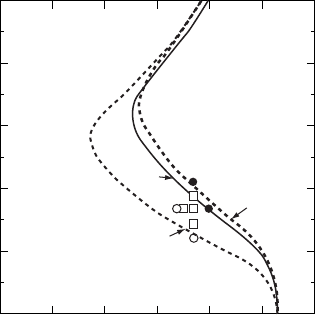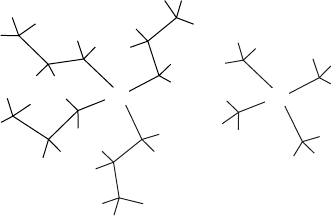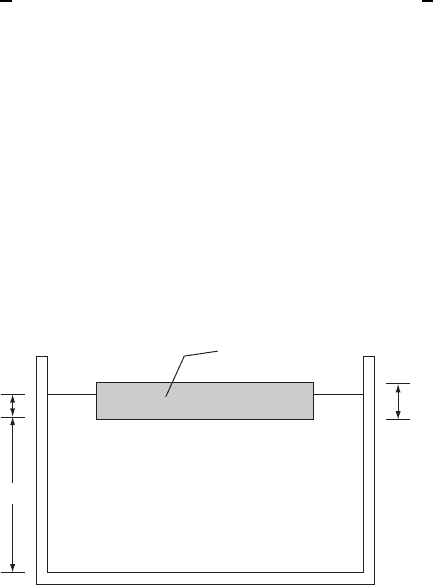Gersten J.I., Smith F.W. The Physics and Chemistry of Materials
Подождите немного. Документ загружается.


SYNTHESIS AND PROCESSING OF MATERIALS 393
1.6
2.0
2.4
1.2
0.8
0.4
10
−6
10
−5
10
−4
10
−3
10
−2
10
−1
10
0
( CH
4
)
No condensed
phase
( C
2
H
2
)
Solid carbon
g
d
d ( 760 )
T( 10
3
K )
r
c
( C / C + H )
Figure W21.30. CVD phase diagram for the C–H system. The regions of stability of solid
carbon (i.e., diamond or graphite) are presented at P D 5 ð 10
3
Pa as functions of temperature
T and reactant ratio C/C C H. [Reprinted from M. Sommer, K. Mui, and F. W. Smith, Solid
State Commun., 69, 775 (1989). Copyright 1989, with permission from Elsevier Science.]
are also presented and can be seen to be in very good agreement with the predicted
region of stability of diamond. Similar predictions for the C–H–O system have been
obtained for the deposition of diamond via the oxyacetylene torch.
†
Problems remaining in the CVD of diamond films are related to obtaining films
with fewer defects and with lower levels of nondiamond components, such as
graphitic carbon, amorphous carbon, and impurities such as hydrogen and nitrogen.
The successful preparation of n-type films is also an important goal for the eventual
use of diamond as an active element in electronic devices. The p-type doping of
diamond by substitutional B acceptors is well established.
In addition to the CVD of diamond films, the synthesis of diamond at high temper-
atures (³ 2000 K) and pressures (³ 60 atm) (i.e., under HPHT conditions) in the form
of small single crystals or abrasive grains is a well-developed technology, with several
tons of diamond being prepared yearly. Under these conditions, diamond is appar-
ently thermodynamically stable with respect to graphite, although the phase boundary
between diamond and graphite is still not very well known in the HPHT region. The
HPHT method relies on the solubility of carbon in molten transition metals such as Ni
at high T and P and its subsequent controlled precipitation as diamond crystals.
Cubic BN (c-BN) with the zincblende crystal structure is similar in many respects to
diamond, having essentially the same lattice constant, a wide bandgap (³ 6.4eV)and
also very high hardness and thermal conductivity. c-BN is actually superior to diamond
for electronic applications due to the fact that it can be doped both n-andp-type with
Si and Be, respectively. The ceramic c-BN also has excellent potential for use as a
hard, wear-resistant coating for tools since its solubility in ferrous materials is much
†
R. B. Wang, M. Sommer, and F. W. Smith, J. Cryst. Growth, 119, 271 (1992).

394 SYNTHESIS AND PROCESSING OF MATERIALS
lower than that of carbon. So far a successful technique for preparing single-phase
c-BN in thin film or bulk form has not been developed.
W21.15 Synthesis of YBa
2
Cu
3
O
7−x
Early methods of synthesizing the high-temperature superconductor YBa
2
Cu
3
O
7x
(YBCO or 1:2:3) involved a solid-state self-flux reaction resulting in a metastable
compound. Typically, a mixture of BaCO
3
,CuO,andY
2
O
3
with the molar ratios
Y/Ba/Cu D 1:4:10 was mixed and ground in a zirconia crucible, pressed into pellets,
and heated at 890
°
C for a day. The process was repeated a second time. Finally,
the material was annealed at 1000
°
C while being subjected to flowing O
2
for three
days. The cooling rates had to be slow to obtain crystals of size ³ 1 mm. The parent
compound is YBa
2
Cu
3
O
7
, which is nonstoichiometric. This compound is enriched with
oxygen as the O atoms intercalate into the crystal and order. The oxygen content of
the crystals (7 x) was found to be a function of the oxygen partial pressure during
annealing. Optimal values of T
c
(³ 90 K) were obtained for x D 0.3. To obtain crystal
growth the temperature had to be sufficiently high to obtain a partial melt, yet suffi-
ciently low so as not to decompose the crystals to more thermodynamically stable
forms (such as Y
2
BaCuO
5
). A ternary phase diagram is given in Fig. W21.31.
The deposition of thin films of YBCO requires a different approach. Methods such
as magnetron sputtering, pulsed excimer-laser ablation, and metal-organic chemical
vapor deposition (MOCVD) have been developed. A proper choice of substrate has
to be made so that epitaxial growth will occur. YBCO is an orthorhombic crystal
with lattice constants a, b,andc D 0.383, 0.389, and 1.169 nm. Suitable substrates for
growing crystals with the c axis normal to the substrate surface are the (100) faces
of SrTiO
3
(a D 0.39 nm) and LaAlO
3
(a D 0.536 nm ³ a
p
2). These substrates have
high melting temperatures, T
m
D 2030
°
C and 2110
°
C, respectively, and also have low
microwave loss, which is important in designing superconducting microwave filters
and cavities.
BaO
Ba
4
Y
2
O
7
Ba
2
Y
2
O
5
Ba
2
CuO
3
BaCuO
2
Ba
3
Y
4
O
9
BaY
2
O
4
Y
2
Cu
2
O
5
CuO
2:1:1
1:2:3
∼1:4:2
∼1:5:3
P
ss
Y
2
O
3
1
2
Figure W21.31. Ternary phase diagram for Y–Ba–Cu –O. The numbers x:y:z refer to the
Y:Ba:Cu stoichiometry. P
ss
denotes a solid solution region. The temperature is T ³ 975 to
1000
°
C. (Adapted from L. F. Schneemeyer et al., Barium yttrium copper oxide crystals, in
D. W. Murphy and L. V. Interrante, eds., Inorganic Synthesis, Vol. 30, Wiley, New York, 1995.)
SYNTHESIS AND PROCESSING OF MATERIALS 395
In the MOCVD method the cations are bound to organic anions, and the resulting
metal–organic precursor has a high vapor pressure at relatively low temperatures
(³ 250
°
C). An inert carrier gas such as Ar is used. Precursors such as Ba(THD)
2
,
Cu(THD)
2
, and Y(THD)
3
are used, where THD is bis(2,2,6,6-tetramethyl-1,3,5-
heptanedione). Oxygen is introduced. The vapor is transported to the heated substrate,
where the organic components are pyrolyzed and the oxides of the cations are deposited.
In this method the substrate is the hottest part of the system, so the deposition takes
place only on the substrate, not on the walls of the system.
In pulsed laser deposition (PLD) a Kr–F excimer laser generates a D 248 nm pulse
of duration 30 ns with a fluence of ³ 5 ð 10
4
J/m
2
. The pulse is absorbed near the
surface of a block of material that is to be deposited on a substrate some distance away.
The pulse has sufficient energy to vaporize (and partially ionize) several hundred layers
of atoms. A plume of ablated material is cast off primarily in the forward direction
perpendicular to the target. The substrate temperature is in the range 500 to 700
°
C,
which provides sufficient atomic mobility for crystal growth to occur. The deposited
layer retains the chemical composition of the target. Unlike the MOCVD method, one
is not dependent on all the precursors having a high vapor pressure.
W21.16 Synthesis of Si
3
N
4
There exist a variety of methods for synthesizing Si
3
N
4
powders, but only three
methods are used commercially. They are carbothermal reduction and nitridation, direct
nitridation of silicon, and a liquid-phase process. Si
3
N
4
exists in two phases, a low-
temperature metastable ˛-phase and a high-temperature stable ˇ-phase. Both phases
have a hexagonal unit cell, but the stacking sequences of the planes along the c axis
are different. The ˛-phase has the stacking sequence ABABABAB... ,whereasthe
ˇ-phase has the sequence ABCDABCD... .The˛-phase can readily accommodate
cations within its structure.
In the carbothermal reduction and nitridation process silica reacts with carbon in a
nitrogen atmosphere according to the overall formula
3SiO
2
s C 2N
2
g C 6Cs ! Si
3
N
4
s C 6COg. W21.30
The reaction occurs at temperatures in excess of 1420
°
C at atmospheric pressure and is
endothermic with H D 1270 kJ/mol. To prevent the reverse reaction from occurring,
the CO gas must be removed. Unless impurities are added the reaction strongly favors
the production of the ˛-phase. The reaction proceeds in several stages. One possible
route is to produce a supersaturated SiO gas and then have this gas react with carbon
and nitrogen. Some possible pathways are
SiO
2
C C ! SiO C CO, 3SiO C 3C C2N
2
! Si
3
N
4
C 3CO,W21.31
or
SiO
2
C C ! SiO C CO, 3SiO C3CO C 2N
2
! Si
3
N
4
C 3CO
2
,
W21.32
followed by
CO
2
C C ! 2CO.W21.33
Other reactions are possible as well.
396 SYNTHESIS AND PROCESSING OF MATERIALS
The direct nitridation of silicon involves “burning” solid silicon in a nitrogen atmo-
sphere to promote the exothermic reaction
3Sis C 2N
2
g ! Si
3
N
4
s. W21.34
The enthalpy of formation is
f
H
o
D730 kJ/mol at a temperature of 1320
°
C. This
reaction produces a mixture of both the ˛-phase and the ˇ-phase. It is possible to
reaction-sinter the Si
3
N
4
by slowly raising the temperature to ³ 1400
°
C and keeping
it at that temperature for several days. Then the ˇ-phase is produced.
The liquid-phase process involves pouring liquid silicon tetrachloride into liquid
ammonia at P D 230 Pa and T D29
°
C. The SiCl
4
is dissolved in an organic solvent
composed of cyclohexane and benzene. A polymer of silicon diimide is formed at the
interface according to the reaction
nSiCl
4
C 18nNH
3
! SiNH
2
n
C 4nNH
4
ClÐ3NH
3
. W21.35
The (Si(NH)
2
)
n
dissolves in the organic solvent. The solvent, ammonia, and NH
4
Cl are
then removed and the silicon diimide is heated to 1000
°
C to convert it to amorphous
silicon nitride according to the reaction
3SiNH
2
n
! nSi
3
N
4
C 2nNH
3
. W21.36
Further heating anneals the amorphous material to crystalline ˛-Si
3
N
4
.
Densification of Si
3
N
4
can be accomplished, for example, by liquid-phase sintering.
The Si
3
N
4
is mixed with silica and additives such as alumina and yttria which are
used to lower the melting temperature of the silica. This is important because Si
3
N
4
has a low dissociation temperature (1500
°
C) and it is desirable to keep the liquid
temperature at around 1470
°
C. In the sintering process the silica and additives melt,
some of the Si
3
N
4
goes into solution and precipitates out, ultimately causing the grains
to merge and to eliminate the intergranular void spaces. The microstructure that results
is strongly influenced by the additives used.
It is also possible to densify Si
3
N
4
powders by means of hot pressing, hot isostatic
pressing, or gas pressure sintering. Oxides, such as MgO or Y
2
O
3
,orBeSiN
2
are added
as sintering aids.
It is possible to deposit Si
3
N
4
films by means of CVD. The precursors are ammonia
(NH
3
) and dichlorosilane (SiCl
2
H
2
). The operating temperature is 700 to 800
°
C. Unfor-
tunately, this is too high for application to electronic VLSI chips. PECVD is used to
reduce the operating temperatures to below 450
°
C, in which case amorphous films also
containing H are deposited.
Laser reactions may also be used to synthesize Si
3
N
4
. A mixture of NH
3
and SiH
4
is irradiated with infrared radiation from a CO
2
laser. The SiH
4
is vibrationally excited
and the net endothermic reaction
3SiH
4
g C 4NH
3
! Si
3
N
4
s C 12H
2
g W21.37
is able to proceed. Particles of size ³ 20 to 100 nm are produced.
SYNTHESIS AND PROCESSING OF MATERIALS 397
W21.17 Synthesis of SiC
At low temperatures (T<1800
°
C) one may sinter powders of Si and C to produce the
ˇ (zincblende) form of SiC via the reaction Si C C ! SiC. For temperatures higher
than 2000
°
C, hot pressing may be used. Silicon carbide is most commonly synthesized
using the Acheson process, which employs a resistance furnace. A mixture consisting
of carbon, NaCl, SiO
2
sand, and some sawdust is placed around a core of graphite.
An electrical current is passed through the graphite, heating it to a temperature of
around 2600 to 2700
°
C (below the melting temperature of 2830
°
C). The reaction
SiO
2
C 3C ! SiC C 2CO is highly exothermic, with H D 14, 700 kJ/kg, and this
helps create the high temperature. The ˛ (wurtzite, high temperature) form of SiC
grows around the graphite core. The NaCl helps to remove impurities from the material.
The sawdust creates sufficient pore space so that the CO gas may escape.
The Lely process is another way of synthesizing SiC. Amorphous SiC granules are
placed inside a hollow graphite tube and the combination is heated to ³ 2500
°
Cinan
inert gas such as Ar. Some of the SiC sublimes, forming a vapor. From this vapor SiC
crystals nucleate on the granules and then continue to grow.
Silicon carbide may also be grown by chemical vapor deposition on a hot
substrate. The temperatures are typically much cooler than used in the Acheson and
Lely processes. The precursor gases that are used are silane, (SiH
4
)andmethane
(CH
4
) or propane (C
3
H
8
). Typical net reactions are SiH
4
C CH
4
! SiC C4H
2
or
3SiH
4
C C
3
H
8
! 3SiC C 10H
2
. Laser-induced reactions are also possible, such as
2SiH
4
C C
2
H
4
! 2SiC C 6H
2
. It is also possible to use single molecules called
carbosilanes, containing Si and C in a 1:1 ratio, as the precursor. Included are molecules
such as 1,3-disilacyclobutane. It is possible to produce ˇ-SiC at temperatures ³ 1000
°
C
and even lower. Other molecules in use include 1,3-disila-n-butane and methylsilane
(CH
3
SiH
3
).
Silicon carbide powders may be formed into shapes using methods such as extrusion,
injection molding, and hot isostatic pressing, among others. SiC may be sintered using
the hot-pressing technique at temperatures in excess of 2000
°
C.
Of the various methods for preparing SiC, CVD produces the highest-quality crys-
tals. For example, a thermal conductivity of A D 300 W/mÐKatT D 300 K is attain-
able, compared with values in the range 15 to 120 for sintered SiC, 120 to 170 for
reaction-bonded SiC, and 50 to 120 for hot-pressed SiC. CVD SiC also yields the
material with the highest elastic modulus, E D 466 GPa, and the lowest coefficient of
thermal expansion, 2.0 ð10
6
K
1
, at room temperature.
W21.18 Synthesis of the Zeolite ZSM-5
Sol–gel synthesis is also used to produce the zeolite ZSM-5, introduced in Section 13.6.
This zeolite is an aluminosilicate in which the silicon-to-aluminum ratio is very high. A
typical procedure is to first prepare NaAlO
2
by Al
2
O
3
C 2NaOH ! 2NaAlO
2
C H
2
O
and then put it in a solution of NaOH and H
2
O. A second solution is prepared by
dissolving a small amount of tetrapropylammonium bromide in H
2
SO
4
and water. The
solutions are combined with a sol consisting of silica, Na
2
O, and water. The silica-
to-alumina ratio can be kept high to make the resulting crystal almost entirely silica.
The resulting solution is kept at 95
°
C for up to two weeks and the sol–gel reaction is
monitored closely to see when crystallites of the zeolite form. When the crystallization
is complete, the organic molecules can be slowly pyrolyzed in oxygen at elevated

398 SYNTHESIS AND PROCESSING OF MATERIALS
N
+
N
+
TPA TMA
Figure W21.32. Tetrapropylammonium (TPA) ion and tetramethylammonium (TMA) ion.
[Adapted from D. W. Lewis et al., Nature, 382, 604(1996).]
temperatures. The resulting crystal consists mainly of tetrahedrally coordinated silica
with aluminum ions incorporated into the framework. Sodium ions (equal in number
to the Al ions for charge balance) reside outside the framework in the pore spaces. The
zeolite serves as an ion exchanger, so other ions may be substituted for the sodium.
The tetrahedral molecule tetrapropylammonium (TPA) ion (Fig. W21.32) serves as
a template molecule upon which the zeolite nucleates. The framework and pore size of
the crystal are determined by the geometry of this ion. The steric hindrance presented
by the ion guarantees a large pore size. Since the charge on the TPA ion is C1e,it
serves to compensate for the valence deficit that occurs when an Al
3C
ion replaces a
Si
4C
ion. Each of the TPA propyl groups extends into one of the four channels that
emanate from each intersection, with the nitrogen atom residing at the junction. If other
ions are used, the pore size will be different. This gives the chemist the opportunity to
custom design zeolite structures based on the template molecule employed.
Recent observation of the formation and growth of a similar material, zeolite A
(Na
12
[(AlO
2
)
12
(SiO
2
)
12
]Ð27H
2
O), identified the steps involved in the formation of crys-
tals.
†
The monomers polymerized to form small amorphous clusters of aluminosilicate
particles with diameters in the range 5 to 10 nm in solution. Tetramethylammonium
(TMA) (see Fig. W21.32) is used as a template for zeolite A. When TMA is added to
the solution, the solution becomes basic and the particles aggregate to form amorphous
gel particles, with sizes in the range 40 to 80 nm. The aggregation is presumably due
to the screening of the Coulomb repulsion between the particles by the ions in solution,
allowing the long-range van der Waals forces to bring the particles together. After three
days at room temperature, single crystals nucleate within the gel particles and grow to
the size 10 to 30 nm. After a week there is complete conversion of the gel particles to
the single crystals, of size 40 to 80 nm. Presumably the high supersaturation present
in the amorphous gel particles is the driving force for the nucleation and growth of
the crystals. If the temperature is then elevated to 80
°
C, there is transport through the
solution and the crystals undergo Ostwald ripening. Larger crystals in the range 200
to 400 nm are formed within one day.
By using micelles as the templating agent it is possible to produce mesoporous films
of transition metal oxides with variable pore sizes.
‡
The micelles are rodlike structures
†
S. Mintova et al., Science, 283, 958 (1999).
‡
T. Sun and J. Y. Ying, Nature, 389, 704 (1997).

SYNTHESIS AND PROCESSING OF MATERIALS 399
that are self-assembled from hexylamine molecules, with the molecular axes directed
perpendicular to the rod axis. The length of the hydrocarbon chain determines the
radius of the rod.
It has been reported
†
that zeolite-like materials with helical pores could be
constructed by using inorganic cations or amines as templates. In place of the
aluminosilicate structure of ZSM-5, the inorganic framework is based on zinc
and beryllium arsenate and gallium germanate. Such structures could serve as
chiral catalysts that would yield products with enantioselectivity (i.e., with a fixed
handedness).
W21.19 Synthesis of the Perovskite PLZT
Lead zirconate titanate, Pb(Zr,Ti)O
3
(PZT), is a ceramic material used in the electronics
and optics industries. There are a number of ways of synthesizing it. Powders can be
made by the solid-state reaction method or by wet chemical synthesis.
In the solid-state reaction method the reagent powders PbO, ZrO
2
,andTiO
2
are
mixed, ground, and then heated at 850
°
C for about 3 hours, during which time crys-
tallization takes place. To create the daughter compound Pb
1x
La
x
(Zr
y
Ti
1y
)
1x/4
O
3
(PLZT) one uses a combination of La
2
O
3
and ZrO
2
instead of pure zirconia.
Wet chemical methods include coprecipitation, hydrothermal synthesis, and sol–gel
synthesis. An example of the coprecipitation method is to mix various salts together
with ammonium hydroxide and water, for example,
1 xPbCl
2
C xLaCl
3
C y
1
x
4
ZrCl
4
C 1 y
1
x
4
TiCl
4
C 6NH
4
OH
! 1 xPb(OH)
2
C xLa(OH)
3
C y
1
x
4
ZrO(OH)
2
C 1 y
1
x
4
TiO(OH)
2
C
1
x
4
H
2
O C 6NH
4
Cl.W21.38
The various hydroxides form a gel precipitate. The solution is washed to eliminate
the ammonium chloride salt. It is then heated at a temperature of 550
°
C for an hour
during which time the hydroxide groups are converted to water and the PLZT crystals
are formed through the reaction
1 xPb(OH)
2
C xLa(OH)
3
C y
1
x
4
ZrO(OH)
2
C 1 y
1
x
4
TiO(OH)
2
! Pb
1x
La
x
Zr
y
Ti
1y
1x/4
O
3
C
2 C
x
4
H
2
O.W21.39
Hydrothermal synthesis allows the reaction to occur at lower temperatures (350
°
C),
but at higher pressures.
The sol–gel synthesis of PLZT utilizes precursors typically consisting of metal
salts (lead acetate hydrate and lanthanum acetate hydrate) and alkoxides (zirconium n-
propoxide and titanium isopropoxide). Salts are used because the alkoxides of lead and
†
T. E. Gier et al., Nature, 395, 154 (1998).
400 SYNTHESIS AND PROCESSING OF MATERIALS
lanthanum are not soluble. The acetates are added to an alcohol such as methoxyethanol
in water. Reactions such as
Pb(OAc)
2
C ROH ! Pb(OAc) (OR) C HOAc W21.40
or
4Pb(OAc)
2
C H
2
O ! 3Pb(OAc)
2
ÐPbO C 2HOAc W21.41
occur, with corresponding ones for La(OAc)
3
.HereRD C
2
H
4
OCH
3
and it is seen that
the reaction replaces the OAc ion by an OR ion. Typical condensation reactions that
can occur are
A(OR)
4
C B(OAc)
n
! OR
3
A–O–B(OAc)
n1
C ROAc,W21.42
where n D 2or3,AD Ti or Zr, B D Pb or La, and R D C
3
H
7
or C
2
H
4
OCH
3
.
Thin films of PLZT created by the sol–gel process may be spun onto silica or MgO
substrates while still wet and then dried. The films may be processed further for various
applications.
W21.20 Synthesis of Glasses: Pilkington Process
The synthesis of glass involves essentially three steps. In the first step a batch of raw
materials is prepared. The principal ingredient is SiO
2
. Modifier oxides, such as Na
2
O
or K
2
O, are added to lower the melting temperature. Other oxides, such as CaO, are
added to provide chemical stability. If a glass-ceramic with controlled crystallinity is
to be produced, Al
2
O
3
is also added.
In the second stage the mixture is melted. For common glasses the temperature is
elevated to 1300 to 1400
°
C, while for glass-ceramics the temperature range is 1400 to
1500
°
C. Volatile gases leave the liquid. The viscosity of the liquid decreases rapidly
with increasing temperature, so the rate of escape of the gas bubbles is sensitive to
temperature.
The final stage involves forming the glass into the desired shape. Techniques such
as rolling, blowing, casting, pressing, and drawing are used. In creating ordinary glass
the cooling rate is as fast as it can be without producing cracking. If it is too high, the
temperature differential between the surface and interior portions of the glass produces
stress fields that could lead to cracking. In creating glass-ceramics, slower cooling is
required. The cooling rate is critical in determining the amount of crystallization that
will occur. Residual stresses may be eliminated or reduced by annealing the glass.
In some cases the surface of the glass is tempered to enhance its mechanical prop-
erties. For example, one may heat the glass uniformly in a furnace, remove it, and
then rapidly cool the outer surface. Due to the poor thermal conductivity of glass,
the interior remains hot for some time. Viscoelastic relaxation allows the atoms in the
interior to assume new configurations to relieve the stress. Upon further cooling the
glass becomes so viscous that relaxation no longer can occur and the interior develops
a tensile stress in response to the thermal contraction. Correspondingly, the surface
region is put in a state of compressive stress. The existence of the internal stress field
permits the glass to withstand larger flexural stresses that may be imposed on it.
In addition to thermal tempering, chemical tempering is also possible. For example,
by exchanging the Na
C
ions for smaller Li
C
ions near the surface, the surface is placed

SYNTHESIS AND PROCESSING OF MATERIALS 401
under compressive stress. It is also possible to remove Na by exposing the glass to
gases such as SO
2
and H
2
O. Effectively, the Na
C
ions are replaced by protons from
the water, producing OH radicals.
The Pilkington process,orfloat process, represents more of a manufacturing process
than a change in the microstructure of a material. It is included here because it shows
the importance of surface tension in a practical manufacturing setting. The process
provides an economical means for large-scale production of finished sheets of glass.
Molten glass is poured onto a tub of molten metal and is allowed to float until it cools
below the glass temperature, T
g
.IfT
m
is the melting temperature of the metal, then if
T
m
<T<T
g
, the solidified glass that forms will float on the molten metal and may
readily be removed. Tin is usually used as the metal because it melts at a sufficiently
low temperature (T
m
D 232
°
C).
Let ,
m
and ,
g
be the densities of the metal and glass. For flotation it is required
that ,
m
>,
g
. For tin and glass the specific gravities are 6.5 and 2.2, respectively.
The interfacial surface tensions are denoted by -
mv
, -
gv
,and-
mg
, where the subscript
v refers to the surrounding atmosphere (without oxygen). The thickness of the glass
sheet will be denoted by t and its base area by A. The base area of the vat of metal is
A
0
. The geometry is depicted in Fig. W21.33.
To find t one minimizes the total potential energy, consisting of gravitational and
surface contributions,
U D
1
2
,
m
g[Ay h
2
C A
0
Ay
2
] C ,
g
gAt
y h C
t
2
C -
gv
A C -
mg
A C -
mv
A
0
A, W21.43
subject to the constraints of constant glass and metal volumes
V
m
D Ay h C A
0
Ay, W21.44
V
g
D At. W21.45
The surface energy associated with the vertical sides of the slab is small and is
neglected. Introducing Lagrange multipliers and C, one has
υU CV
m
V
g
D 0.W21.46
A
A'
y–h
h
t
r
m
r
g
v
Figure W21.33. Slab of molten glass floating on a bath of molten metal in the Pilkington
process.

402 SYNTHESIS AND PROCESSING OF MATERIALS
The partial derivatives are taken independently with respect to the variables y, h, t,
and A to obtain the four equations
,
m
gA
0
y Ah C ,
g
Agt CA
0
D 0,W21.47
,
m
gy h C ,
g
gt D C, W21.48
,
G
gy h C t D , W21.49
1
2
,
m
gh
2
2hy C ,
g
gt
y h C
t
2
C -
gv
C -
gm
-
mv
C Ch t D 0.W21.50
Eliminating the Lagrange multipliers results in
,
m
h D ,
g
t, W21.51
which could have been deduced from Archimedes principle, and a formula for t,
t D
2,
m
-
gv
C -
gm
-
mv
g,
g
,
m
,
g
,W21.52
independent of the volume of the glass. Note that it is necessary for -
gv
C -
gm
>-
mv
;
otherwise, the glass would spread, with A ! A
0
. Since the interfacial surface tensions
are dependent on T, one has some control over the thickness of the sheet by varying
the temperature and the cooling rates.
By applying a tensile stress to the sheet of glass while it is cooling, it is possible to
stretch it and thereby make it thinner, according to the relation t D V
g
/A. Let a constant
external tension per unit thickness = D S/t be introduced, where S is the tension. This
is equivalent to adding the term =A to the potential energy, so replacing the term -
gv
by -
gv
= gives the result
t D
2,
m
-
gv
C -
gm
-
mv
=
g,
g
,
m
,
g
.W21.52
0
As the parameter = increases, the thickness t decreases.
W21.21 Synthesis of Polycarbonate
Polycarbonate is synthesized by means of a polymerization reaction that occurs at the
interface between two immiscible liquids. One liquid is an organic solvent (such as
methylene chloride, CH
2
Cl
2
) and the other is a basic solution (such as NaOH in water)
which acts as the initiator for the reaction. The starting material for the monomer
from which the polymer is built is bisphenol-A, C(C
6
H
4
)
2
(CH
3
)
2
(OH)
2
, and is soluble
in the organic solvent. The organic solvent is dispersed into small globules in the
alkaline solution. Phosgene gas, CCl
2
O, is bubbled through the emulsion. The primary
reaction is
CC
6
H
4
2
CH
3
2
OH
2
C CCl
2
O C NaOH ! CC
6
H
4
2
ð CH
3
2
OHCClO
2
C H
2
O C NaCl.W21.53
